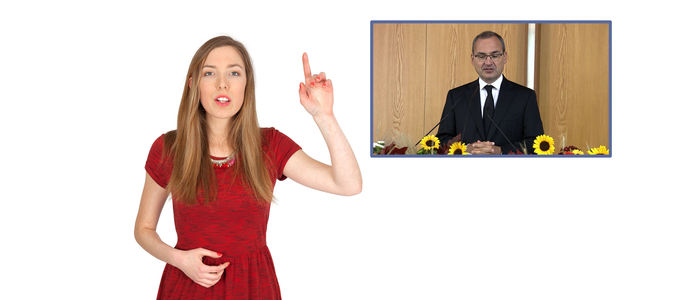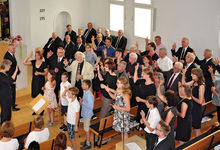Listening with the eyes
Although fully concentrated, they sit in divine service without understanding a word. When central divine services are broadcast by satellite, some brothers and sisters go home almost the same way they came, because their world is the world of Signed Language. But things are changing.

About 200,000 people in Germany use DGS, German Sign Language. Its words consist of a combination of hand shapes, movement of the hands, arms, or body, and facial expressions. Such systems of manual communication also exist in other countries, such as in the United States, where it is estimated that anywhere from 250,000 to 500,000 people use ASL, American Sign Language.
Singing with your hands, listening with your eyes
In the German-speaking regions there are about 250 hard-of-hearing or deaf brothers and sisters, who use this means of communication. They attend regularly divine services in their congregations, which are interpreted for them into Sign Language by hearing brothers and sisters.
The deaf brothers and sisters also meet regularly to make music, sing together in a Sign Language choir, and attend divine services, which Priests celebrate in Sign Language. But as soon as there is a transmission service say by the Chief Apostle or the District Apostle, the deaf and the hard of hearing lose out.
The go-ahead for Sign Language interpreters during transmissions
“The District Apostles have agreed to transmit Sign Language during transmission services in the German-speaking areas.” This is the unanimous decision that was reached following the last meeting of the European District Apostles in November 2016. The District Apostles agreed to launch an additional transmission channel for divine services, and this one exclusively for the deaf and hard of hearing.
Detailed plans are being worked out. In the months to come, church districts across Germany will be equipped with the necessary technology. To be able to receive the signal in the churches, a receiver has to be installed. This additional transmission is based on IPTV, Internet Protocol Television, which allows for the streaming of data. It requires an Internet connection at the place where the broadcast is received.
Zooming in on the Sign Language interpreter
Beginning in the coming year, central divine services in Germany will be transmitted in Sign Language to selected churches. The transmission will be realized by Bischoff Publishers. Like the interpreters say for French or Romanian, there will also be an interpreter for German Sign Language. He or she, however, will not be sitting in a sound-proof booth like the others, but will be in a specially set up TV studio.
A camera will film the Sign Language interpreter’s signing and transmit a combined image: the interpreter’s gestures will take up the greater part of the screen. The officiant will be seen somewhat smaller.
Two hands say it all
Many who attend such divine services will not even notice that something different is happening. The Sign Language interpretation will be transmitted separately, as a second broadcast, and will be screened in selected churches or in adjoining rooms only. For some brothers and sisters, however, this innovation means that they will be able to follow the sermon live and understand it.
After the end of the first transmission in Sign Language, more than one of the members will undoubtedly flash a grateful smile and raise their dominant hand with the fingers extended—and the back of the hand pointing forward—to their chin. This is the sign for “thank you”.
Photo: NAK International/Chris Bourloton
Article info
Author:
Date:
Keywords:
Oliver Rütten
08.12.2016
Germany,
Media,
Divine service,
Congregational life





